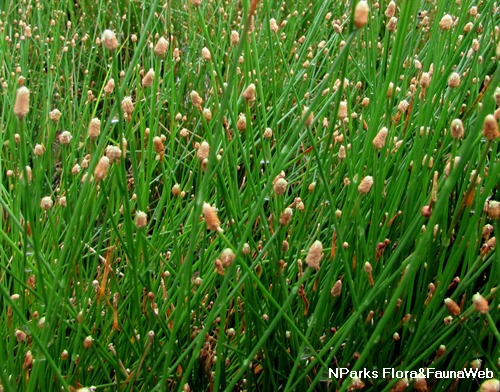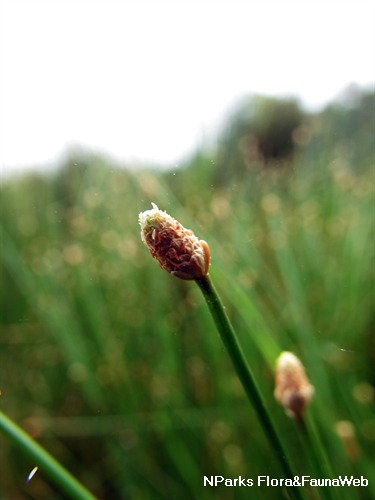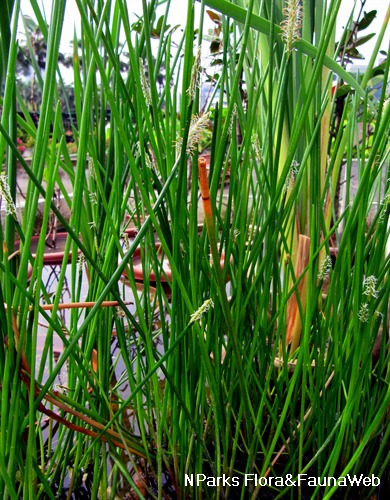
Back
Eleocharis palustris (L.) Roem. & Schult
| Family Name: | Cyperaceae |
| Common Name: | Common Spikerush, 沼泽荸荠 |
Name
Classifications and Characteristics
| Plant Division | Angiosperms (Flowering Seed Plants) (Monocotyledon) |
|---|---|
| Plant Growth Form | Grass or Grass-like Plant |
| Lifespan (in Singapore) | Perennial |
| Mode of Nutrition | Autotrophic |
| Plant Shape | Grassy |
Biogeography
| Native Distribution | North America, Europe, Middle East, North Africa, Nepal, Kazakhstan, China, Japan |
|---|---|
| Native Habitat | Terrestrial, Aquatic (Freshwater Pond / Lake / River) |
| Preferred Climate Zone | Temperate |
| Local Conservation Status | Non-native (Horticultural / Cultivated Only) |
Description and Ethnobotany
| Roots | Dense network of long creeping rhizomes (1.5–4.5 mm thick) that extends deep (around 40cm) into the soil. Adventitious roots also arise from the rhizome at the nodes. Internodes ranged from 10mm to 35mm. Haulm and rhizome axis meet at the internode region. |
|---|---|
| Foliage | The leaves are basal and reduced to sheaths, giving the appearance that the plant is leafless. Leaf sheaths base are basally blood–red purple. |
| Stems | The stem is upright and round; and occurs singular or in small clusters. Height usually ranged from 10–100cm depending on the depth of water, if available, in its growing environment. |
| Flowers | Each stem is topped by a solitary terminal spikelet consisting of numerous inconspicuous greenish-brown flowers. The shape of a spikelet ranged from ovoid to lanceoloid (5–40mm long). |
| Fruit | The small (1–2mm) biconvex scaly nutlet turns from yellowish to brownish when matured. |
| Habitat | Range from Terrestrial to wetlands. Elevation range from 0 m to 3000 m |
| Etymology | Genus name comes from the Greek words elos meaning marsh and charis meaning grace. Species palustris refers to marshes. |
Landscaping Features
| Landscape Uses | Pond / Lake / River, Marsh / Bog |
|---|
Fauna, Pollination and Dispersal
| Pollination Method(s) | Abiotic (Wind) |
|---|---|
| Seed or Spore Dispersal | Biotic (Fauna) (Vertebrates (Other Mammal)), Abiotic (Water) |
Plant Care and Propagation
| Light Preference | Full Sun, Semi-Shade |
|---|---|
| Water Preference | Lots of Water, Moderate Water |
| Rootzone Tolerance | Moist Soils, Waterlogged Soils |
| Diseases | Little pest or disease problems. Aphids will feed on the stem with little damage. |
| Pest(s) | Sucking Insects |
| Propagation Method | Seed |
Non - Foliar and Storage
| Root Type | Underground |
|---|
Floral (Angiosperm)
| Flower Grouping | Cluster / Inflorescence |
|---|---|
| Flower Location | Terminal |
| Inflorescence Type | Spikelet / Compound Spike |
Fruit, Seed and Spore
| Mature Seed Colour(s) | Brown |
|---|---|
| Mature Seed Texture(s) | Scaly |
| Seed Quantity Per Fruit | Numerous (>20) |
Image Repository
Others
| Master ID | 32269 |
|---|---|
| Species ID | 6677 |
| Flora Disclaimer | The information in this website has been compiled from reliable sources, such as reference works on medicinal plants. It is not a substitute for medical advice or treatment and NParks does not purport to provide any medical advice. Readers should always consult his/her physician before using or consuming a plant for medicinal purposes. |




